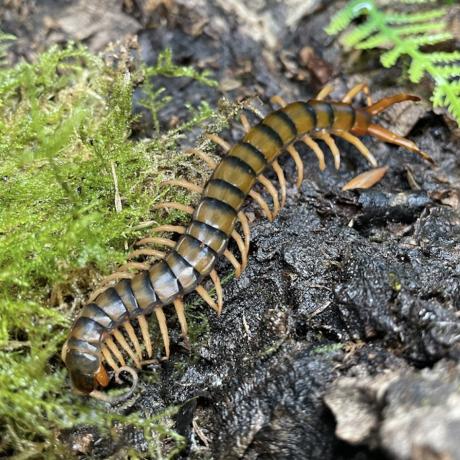

These African centipedes can reach sizes of 15-18cm in length. They are variable in colour, generally seen with the head and body yellow, orange or tan with darker blue-black bands, with yellow, orange or blue legs.
These centipedes can reach sizes of 15-18cm in length. They are variable in colour, generally seen with the head and body yellow, orange or tan with darker blue-black bands. The legs are usually yellow or orange, running in pairs down each segment of the body. They have a pair of elongated mandibles and the first pair of limbs stretch forward over the mouth, ending in sharp points. These claws contain venom glands which enable the centipede to paralyse or kill their prey.
They originate from tropical areas of West Africa.
Centipedes must be housed individually to avoid cannibalism. They are terrestrial, and require a secure, escape proof glass terrarium which is approximately 3x the length of the centipede. The Giant African Centipede requires ambient temperatures of around 23-26°C during the daytime when they are most active. At night time, temperatures can be as low as 18°C. Any heat source used must be controlled by using a suitable thermostat, ensuring your centipede is maintained at the optimum temperature.
Misting the enclosure using a spray bottle dampens the decor, foliage and substrate. Doing this daily helps maintain humidity levels and a shallow water dish can be added.
A soil based substrate to cover the floor to a depth of 10-15cm is recommended and then a layer of leaf litter, cork bark and moss on top can help to retain moisture. The only limit with a natural terrarium is your imagination, we suggest looking at the natural habitat of these centipedes and recreating a small piece of their habitat in your own home!
They will readily prey upon other suitable sized insects, they have a voracious appetite. The bulk of the diet should consist of appropriately sized Crickets, Locusts and Roaches for larger adults. This can be varied by occasionally offering appropriately sized Mealworms, Waxworms, Pachnoda Grubs. Prey should be offered 1-2 times per week. If the food is not eaten by the following day, it is recommended to remove and offer the following week as the centipede may be due to molt.
Please note: Centipedes are not a beginner species, they are fast and defensive. Do not attempt to handle and use long tweezers when feeding or performing tank maintenance.